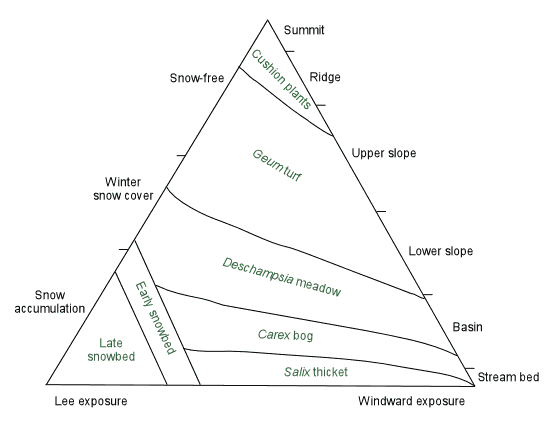 |
|
|
|
|
|
|
The abiotic environment - soil conditions and microclimate - plays a fundamental role in plant growth and vegetation development. In the alpine environment, in contrast to most lowland environments, abiotic conditions often vary profoundly over short distances. Low mean air temperature and low pressure enhance the differences between aspects and small microsites. The relief also affects soil drainage and, together with wind, the amount and duration of snow cover. If you were to walk along a topographical gradient, you would experience abrupt changes in the direction and strength of the wind, varying snow depth, and you might see signs of great variation in soil nutrient conditions. In most alpine areas, the main vegetation types can be characterized by their position along these gradients. |
 |
|
1 - Gradients in topography, wind exposure and snow-cover are responsible for an enormous diversity of vegetation types on the Beartooth Plateau (Wyoming) (after Johnson and Billings, 1962) |

|
|
2 - Community overview |
|
Heterogeneity in abiotic conditions is also created by a variety of disturbances that help to maintain particular plant communities, e.g. the special communities of scree slopes, avalanche tracks etc. These and other factors cause small scale heterogeneity in topography and soil conditions (e.g. soil instability due to freeze-thaw or solifluction), which lead to a correspondingly high heterogeneity of plant communities. Besides abiotic factors determining the composition of alpine vegetation, climate also has a heavy impact on the dynamics within plant communities, primarily by reducing growth rates and slowing down colonization processes. |
29 August 2011 |
||
| |
||